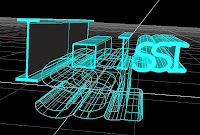
Geometry Gym (or SSI - Smart Structural Interpreter)
SSI is the beta branding for some Rhino plug-ins I've been developing for aprox. the past 12 months.
This project started as a response to various tasks and problems that I'd faced as an engineer working on projects of novel geometry. Primarily this was difficulties in creating analysis models, checking analysis models were coordinated with project drawings, and for coordinating with other design team members, and in how to efficiently describe the geometry of these projects to other team members. But the biggest problem was manipulating models to keep pace with project changes and evolution. Although analysis software has made progress in this area, the methods were still largely manual and time consuming. And part of the problem was that primarily all our drawings were done in 2D (plans, sections, elevations), and the CAD tools we used were focussed on this nature of drawing.
When I arrived in London and started work at Expedition I was introduced to Rhino3D, which is an amazing 3d modelling environment. Rhino has many attributes that make it a fantastic tool for a designer, and I'll list a couple. It can import and export so many CAD file formats (including Microstation and AutoCAD), it has an amazing support group of advanced users on it's newsgroup that will offer advice for everyone from beginner to expert, and for a scripter/programmer, it offers an excellent environment to allow automation and customization for generic and specific problems.
So the two initial plug-ins I've been developing for Rhino are an importer/exporter for structural analysis programs, and a catalouge structural section drawing tool. I'll provide some instructions/examples for using these plug-ins in my following posts. The importer/exporter allows automated drawing and updating of a 3d structural model without the need for manual interpretation and coordination. It also provides advanced tools for efficiently manipulating and generating structural analysis data from within Rhino, so that analysis models can take advantage of the more sophisticated sculpting ability of Rhino than exists commonly in analysis programs. The structural drawing plug-in is basically a sub-set (or by-product) of the first plug-in, that allows designers to manually extrude structural members, or easily add structural sections to rhino documents from a library of standard profiles.






No comments:
Post a Comment